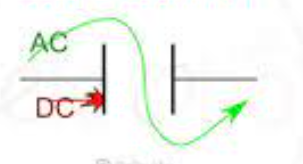Before you understand why capacitor blocks DC and allows AC, you'll have to understand what is a capacitor! It is essentially two electrical conductors separated by a dielectric (insulator). If you add DC to the plates of the electric conductor plates, the dielectric acts as an open switch. Electricity will not pass thru it but the plates will be charged with +ve and -ve voltages respectively. AC current on the other hand, the polarity changes regularly between positive and negative on the plates (AC Signal +ve/-ve sign wave). Capacitors are repeatedly charged and discharged as the current's polarity alternates, allowing AC current to flow through.
Mathematically, capacitive reactance (resistance) of a capacitor is calculated using this formula: XC = 1/(2πfC) - notice the f (frequency) in the formula and it is in the denominator? DC has 0 frequency thus the capacitive reactance XC will be 0 (open circuit - no current flows, AC has frequency greater than 0, eg 60Hz or 50 HZ etc (so the denominator will never be 0, which means the capacitive reactance, XC, in the formula will never be zero also the voltage applied to the capacitor divided by the non-zero value of capacitive reactance XC will result in a current flow


No comments:
Post a Comment